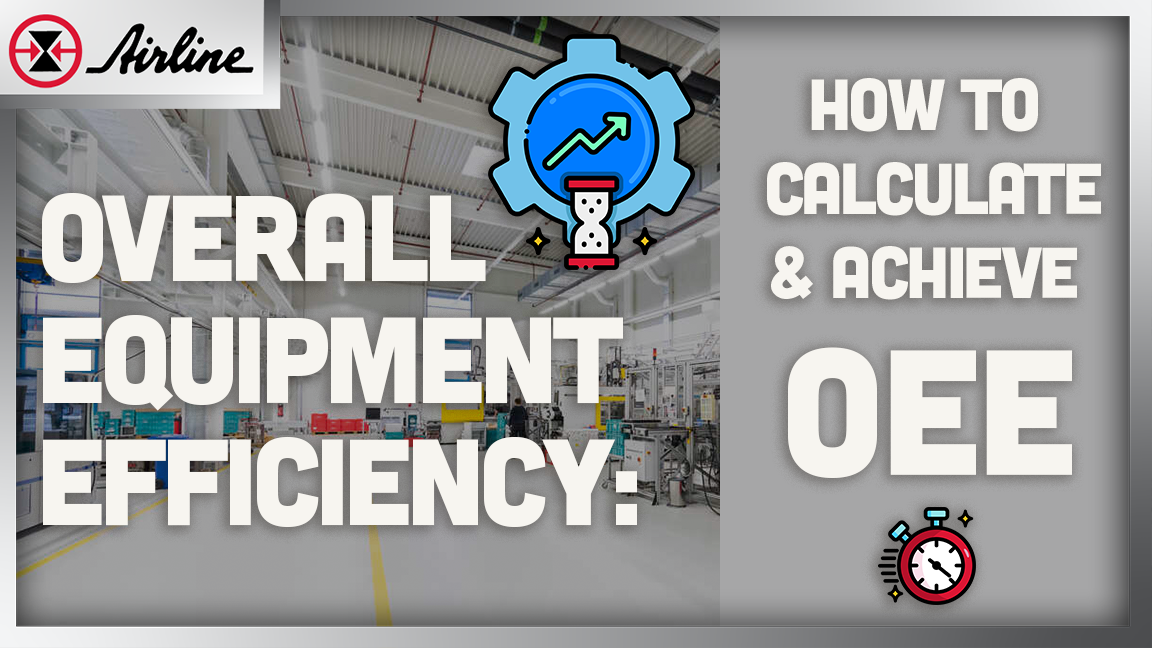Businesses striving to lead the pack, meet Overall Equipment Efficiency (OEE) – the vital process needed for this pursuit. OEE is a gauge that empowers manufacturers to evaluate their production processes, pinpoint areas begging for enhancement, and ultimately increase productivity. Today I’ll review the OEE journey, demystifying what it is, how to compute it, and unveiling strategies to elevate those all-important OEE scores.
Skip to a Section
What Is Overall Equipment Efficiency (OEE)? | OEE formula | Calculating OEE: A Step-by-Step Guide | Strategies to Achieve Higher OEE Scores | Resources
What Is Overall Equipment Efficiency (OEE)?
 OEE is a key performance indicator that quantifies the effectiveness of a manufacturing process by measuring how well equipment is performing in terms of availability, performance, and quality. It provides a comprehensive view of production efficiency, helping businesses pinpoint the root causes of inefficiencies and downtime. A perfect OEE score of 100% signifies you're churning out only flawless products, at maximum speed, with zero downtime. Measuring OEE isn't just a good practice; it's a game-changer. By delving into OEE and its underlying losses, you gain invaluable insights that pave the way for systematic enhancements in your manufacturing process.
OEE is a key performance indicator that quantifies the effectiveness of a manufacturing process by measuring how well equipment is performing in terms of availability, performance, and quality. It provides a comprehensive view of production efficiency, helping businesses pinpoint the root causes of inefficiencies and downtime. A perfect OEE score of 100% signifies you're churning out only flawless products, at maximum speed, with zero downtime. Measuring OEE isn't just a good practice; it's a game-changer. By delving into OEE and its underlying losses, you gain invaluable insights that pave the way for systematic enhancements in your manufacturing process.
The OEE formula is relatively straightforward:
OEE = Availability × Performance × Quality
Let's break down each component:
Availability: This measures the actual runtime of the equipment compared to the scheduled production time. It accounts for downtime due to equipment breakdowns, changeovers, and other unplanned interruptions.
Performance: This factor assesses the velocity at which the equipment functions relative to its utmost possible speed or optimal cycle time. It highlights any slowdowns or inefficiencies during production.
Quality: Quality measures the percentage of defect-free products produced by the equipment. It considers the number of good units produced against the total units produced, including any rework or scrap.
Calculating OEE: A Step-by-Step Guide
To calculate OEE for a specific machine or production line, follow these steps:
Step 1: Determine Availability Percentage
Calculate the total available time for production (Scheduled Production Time - Planned Downtime)Calculate the actual downtime (Unplanned Downtime + Planned Downtime)
Subtract the actual downtime from the total available time and divide by the total available time to get the availability percentage.
Availability (%) = (Total Available Time - Actual Downtime) / Total Available Time
Step 2: Calculate Performance Percentage
Determine the total production count during the actual production timeCalculate the ideal production count, assuming continuous production at the maximum rate
Divide the actual production count by the ideal production count to get the performance percentage
Performance (%) = (Actual Production Count / Ideal Production Count)
Step 3: Calculate Quality Percentage
Determine the total number of good units produced.Calculate the total units produced, including rework or scrap.
Divide the total number of good units by the total units produced to get the quality percentage.
Quality (%) = (Good Units / Total Units Produced)
Step 4: Calculate OEE
OEE (%) = Availability (%) × Performance (%) × Quality (%)
Strategies to Achieve Higher OEE Scores
Now that you understand how to calculate OEE, let's explore strategies to boost your OEE scores:
Predictive Maintenance: Implement a robust maintenance schedule to reduce downtime due to equipment breakdowns.
Learn more about the Why and How of Predictive Maintenance.
Reduced Changeover Times: Minimize changeover times between production runs to increase availability.
Training and Skill Enhancement: Invest in workforce training to improve equipment operation and maintenance.
Quality Control Measures: Implement stringent quality control processes to reduce defects and rework.
Performance Optimization: Identify bottlenecks and inefficiencies in production and take steps to optimize performance.
Real-time Monitoring: Utilize real-time monitoring systems and data analytics to identify and address issues quickly.
Continuous Improvement: Foster a culture of continuous improvement, encouraging employees to seek ways to enhance processes and reduce waste.
Technology Integration: Consider adopting Industry 4.0 technologies like IoT and AI for predictive maintenance and process optimization.
![]() By regularly calculating OEE and implementing these strategies, businesses can identify opportunities for improvement and drive higher productivity and profitability. OEE is a roadmap for achieving operational excellence and staying competitive in today's dynamic manufacturing environment. OEE isn't just a metric; it's a roadmap to identifying losses, gauging progress, and revolutionizing equipment productivity while kicking waste to the curb.
By regularly calculating OEE and implementing these strategies, businesses can identify opportunities for improvement and drive higher productivity and profitability. OEE is a roadmap for achieving operational excellence and staying competitive in today's dynamic manufacturing environment. OEE isn't just a metric; it's a roadmap to identifying losses, gauging progress, and revolutionizing equipment productivity while kicking waste to the curb.
Resources
- Maintenance Solutions Explained
- Predictive Maintenance Made Simple
- How to Collect Data from Existing Sensors & Control Systems | Meet Snap Signal by Banner
- The Why and How of Predictive Maintenance
- From Reactive to Proactive: Predictive Maintenance Solutions by Omron
- How to Run Your Hydraulics for LESS | On-Demand Webinar Sneak Preview








Leave Comment